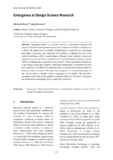Zitierlink:
http://dx.doi.org/10.25819/ubsi/2805Dateien zu dieser Ressource:
| Datei | Beschreibung | Größe | Format | |
|---|---|---|---|---|
| Emergence_in_Design_Science_Research.pdf | 256.61 kB | Adobe PDF |  Öffnen/Anzeigen |
| Dokumentart: | InProceedings |
| Titel: | Emergence in design science research |
| AutorInn(en): | Klesel, Michael Henseler, Jörg |
| Institut: | Forschungskolleg “Institute for Advanced Study” (FoKos) |
| Schlagwörter: | Emergence, Design Science Research, Confirmatory Composite Analysis (CCA), IT Artifact Evaluation, Innovation, Designwissenschaftliche Forschung, Innovation, Bestätigende Verbundanalyse (CCA), Bewertung von IT-Artefakten |
| DDC-Sachgruppe: | 004 Informatik |
| GHBS-Notation: | QGT |
| Erscheinungsjahr: | 2020 |
| Publikationsjahr: | 2020 |
| Auch erschienen: | Radtke, Jörg (Hrsg.) ; Klesel, Michael (Hrsg.) ; Niehaves, Björn (Hrsg.): New perspectives on digitalization: Local issues and global impact. Siegen: Universitätsbibliothek Siegen, 2020. - DOI http://dx.doi.org/10.25819/ubsi/1894, S. 117 - 125 |
| Zusammenfassung: | Designing artifacts is a pivotal activity in Information Systems (IS) research. Beside the development process, the evaluation of artifacts is important as it allows the application of scientific methodologies to generate and accumulate knowledge. Commonly, the evaluation of an artifact is conducted in terms of the artifacts usefulness, utility or performance. Although those evaluation metrics are... |
| DOI: | http://dx.doi.org/10.25819/ubsi/2805 |
| URN: | urn:nbn:de:hbz:467-16366 |
| URI: | https://dspace.ub.uni-siegen.de/handle/ubsi/1636 |
| Lizenz: |  Creative Commons BY-NC-ND 4.0 Creative Commons BY-NC-ND 4.0 |
| Enthalten in den Sammlungen: | Publikationen aus der Universität Siegen |
Diese Ressource ist urheberrechtlich geschützt. |


